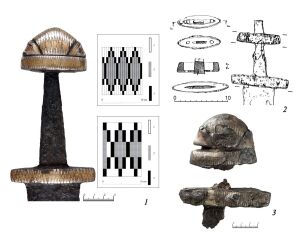 Nikolay A. Makarova,#,
Nikolay A. Makarova,#,
Ekaterina S. Kovalenkob,##,
Mikhail M. Murashevb,###,
Konstantin M. Podurets b,####,
Sergey Yu. Kainovc,#####,
Oleg A. Kondratevb, ######,
Polina V. Guryevab,#######,
Irina E. Zaytseva a,########,
Anastasiya N. Fedorinaa,#########,
Elena Yu. Tereshchenkob,d,e,##########,
Ekaterina B. Yatsishinab,e,###########
aInstitute of Archaeology RAS, Moscow, Russia
bNational Research Centre “Kurchatov Institute”, Moscow, Russia
cState Historical Museum, Moscow, Russia
dInstitute of Crystallography, Federal State Research Centre “Crystallography and Photonics” RAS, Moscow, Russia
eNational Research Centre “Kurchatov Institute” – IREA, Moscow, Russia
#E-mail: nmakarov10@yandex.ru
##E-mail: Kovalenko_ES@nrcki.ru
###E-mail: Murashev_MM@nrcki.ru
####E-mail: Podurets_KM@nrcki.ru
#####E-mail: skainov@mail.ru
######E-mail: Kondratev_OA@nrcki.ru
#######E-mail: Gureva_PV@nrcki.ru
########E-mail: izaitseva@yandex.ru
#########E-mail: nasfed@yandex.ru
##########E-mail: elenatereschenko@yandex.ru
###########E-mail: Yatsishina_EB@nrcki.ru
Keywords: Rus, Suzdal Opolye, sword pommel, neutron and synchrotron visualization, X-ray fluorescence mapping
The article presents the results of synchrotron and neutron visualization of a unique find – the iron pommel base sword unearthed during the works of the Suzdal archaeological expedition of the Institute of Archaeology RAS at the settlement of Krapivye 10 in Suzdal vicinity. The studies were conducted at National Research Centre “Kurchatov Institute”, their task being to restore the pattern of a partially preserved decor on a heavily corroded object with non-destructive methods. The research revealed an inlaid decor made of silver and copper-alloy wires, which made it possible to identify the type of pommel (type V, according to J. Petersen’s typology) and date it from the middle – second half of the 10th century. The find is among the earliest ones in Krapivye 10, a small settlement that emerged in the depths of ravine systems in the middle – second half of the 11th century.
DOI: 10.31857/S0869606323020125, EDN: RGAGZT







